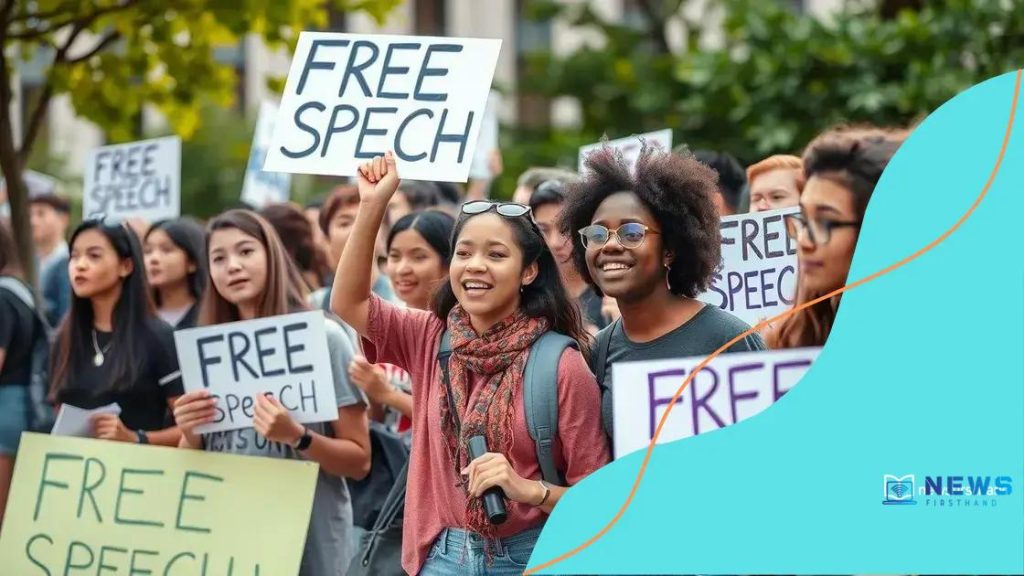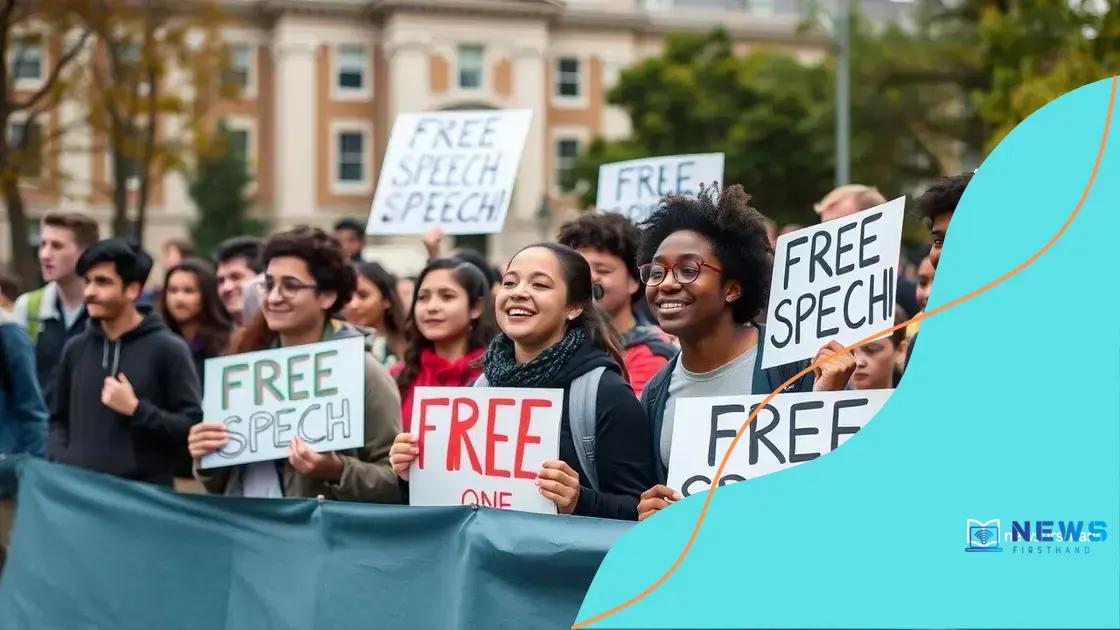Protests against censorship in student-run media

Protests against censorship in student-run media empower students to advocate for free speech, promote transparency, and influence academic policies while facing challenges such as funding and administrative resistance.
Protests against censorship in student-run media are gaining momentum on campuses across the country. As students strive to voice their opinions, issues surrounding freedom of speech keep bubbling to the surface. How are these young activists influencing change?
Understanding the role of student media
Understanding the role of student media is crucial in today’s educational landscape. Student media serves as a voice for young people, allowing them to express their opinions and share important stories.
In many schools and universities, student-run media outlets, such as newspapers, TV stations, and online platforms, play a vital role in promoting free speech. They not only cover campus events but also address broader issues affecting students, like funding, diversity, and mental health.
The Importance of Student Media
Student media fosters a sense of community. It connects students with each other and with their administration. The relationships built through these platforms can lead to increased understanding and collaboration.
- Encourages critical thinking among students
- Promotes transparency in school policies
- Provides hands-on experience in journalism and communication
- Empowers students to voice their concerns and achievements
Moreover, student media acts as a training ground for future journalists. By engaging in this field, students develop essential skills such as research, writing, and multimedia production. This experience is invaluable and prepares them for professional careers.
Challenges Faced by Student Media
Despite its benefits, student media often encounters challenges, including funding issues and administrative censorship. These obstacles threaten the independence that is crucial for free expression.
Many student media outlets struggle to secure enough funding to operate effectively. Financial constraints can limit their ability to cover stories and hire staff, hindering their overall impact. Additionally, some schools impose restrictions on what can be published, stifling creativity and critical voices.
Furthermore, student journalists must navigate the balance between being advocates for student rights and remaining objective in their reporting.
Historical context of censorship in schools
The historical context of censorship in schools offers insight into how student media has evolved. Understanding this background helps us see why current protests against censorship are so vital. Over the decades, schools have grappled with the balance between maintaining order and allowing freedom of expression.
In the early parts of the 20th century, school censorship often came from concerns about morality and societal norms. Many educators believed that controlling the information students received would guide their behavior and beliefs. Throughout the years, significant events challenged these practices.
Key Events Influencing Censorship
Major historical events have shaped how schools respond to student media. For example, the civil rights movement brought attention to issues of equality and free speech.
- The influence of the Supreme Court’s Tinker v. Des Moines case in 1969 is pivotal. It ruled that students do not lose their right to free speech at school.
- The Vietnam War protests highlighted the need for students to voice their opinions without fear of retaliation.
- More recently, debates surrounding social media have forced schools to rethink the implications of censorship.
- The importance of diverse voices in media has driven many school boards to reconsider their policies.
Understanding these events helps clarify why students today are increasingly vocal about their rights. Schools are viewed as spaces for learning and dialogue, not just compliance. Students now expect their voices to be heard and respected.
Opposition to censorship has become more organized in recent years. Student-led movements work together to educate their peers about their rights. They encourage participation in local and national discussions about freedom of the press and expression.
Impact of protests on academic environments

The impact of protests on academic environments is significant and multifaceted. Protests can lead to important changes within schools and universities, affecting policies and the overall culture.
When students engage in protests against censorship, they often bring awareness to critical issues that need addressing. These movements can spark conversations in classrooms that might not have occurred otherwise. Teachers and administrators must consider student perspectives more carefully.
Positive Changes From Protests
One major effect of protests is the promotion of dialogue. When students organize demonstrations, it gives them a platform to express their needs and concerns. This open communication can lead to:
- Changes in school policies regarding free speech and expression
- Greater support for student-led media programs
- A more inclusive environment for discussing diverse viewpoints
- Heightened awareness around important social issues
As students voice their opinions, it often inspires faculty and staff to listen and adapt. This evolution creates a more engaged academic community.
Challenges Faced During Protests
However, protests can also lead to challenges. Tensions between students and administration may rise, and this can create an environment of conflict rather than collaboration. Some administrators may react defensively, reinforcing strict policies instead of loosening them.
Consequently, student activism is not without risks. Students may face disciplinary actions or pushback from peers who disagree with their views. Still, when conducted peacefully, protests can serve as valuable learning experiences for everyone involved.
Through these efforts, students develop essential skills like teamwork, leadership, and advocacy. Such experiences prepare them for future civic engagement and contributions to society.
Case studies of effective student movements
Analyzing case studies of effective student movements provides valuable lessons on how activism can lead to meaningful change. These movements showcase the power students have when they unite for a common cause.
One prominent example is the March for Our Lives movement, initiated by students from Stoneman Douglas High School after a tragic shooting. This movement drew national attention to gun control and mobilized thousands of young people to advocate for policy changes.
Success Factors in Student Movements
Several factors contribute to the success of student movements. Understanding these elements can help future activists improve their strategies.
- A clear goal boosts focus. Movements that define specific objectives tend to resonate more with the public.
- Utilizing social media effectively helps spread awareness and gather supporters.
- Building coalitions with community members or organizations amplifies the message.
- Engaging in peaceful protests keeps the spotlight on the issues without alienating potential allies.
Another inspiring case is the Black Lives Matter movement, which has involved numerous student-led initiatives. Students organized protests and educational events to raise awareness about racial inequality. They have effectively influenced campus policies and highlighted the need for systemic change.
These movements demonstrate that when students use their voices together, they can address pressing issues and demand accountability. The energy seen in these actions encourages others to get involved and raises awareness on important topics.
Future of student-run media and free expression
The future of student-run media and free expression is an exciting yet challenging landscape. As technology advances, student media faces both new opportunities and threats. Understanding these dynamics is crucial for fostering effective platforms for student voices.
With the rise of digital platforms, students can now reach wider audiences. Online blogs, podcasts, and social media enable student-run media to thrive in ways that traditional print media couldn’t. This evolution allows students to share their stories instantly, connecting them with peers and communities beyond their campuses.
Emerging Trends in Student Media
Looking ahead, several trends will shape how student media operates:
- Increased digital engagement: More students are using digital tools for storytelling and journalism, making it essential for media outlets to adapt to these platforms.
- Greater focus on diversity: Student media will likely prioritize diverse voices and perspectives to reflect the community more accurately.
- Collaboration with professional media: Partnerships between student media and established outlets can provide mentorship and resources to enhance journalistic standards.
- Advocacy for free speech: Students will continue to fight for their rights to express opinions and should be involved in discussions about media policy.
Despite these advancements, challenges remain. Issues like censorship and funding pressures can hinder these media outlets. Students must navigate these difficulties while maintaining their commitment to transparency and free expression. Resilience will be key in this journey.
As student media evolves, it will play a vital role in shaping the discourse around important social issues. Engaging more students in discussions about media ethics and responsibilities can empower them and cultivate future leaders.
FAQ – Frequently Asked Questions about Protests Against Censorship in Student-Run Media
What are the main goals of student protests against censorship?
The main goals include advocating for free speech, increasing awareness of media policies, and ensuring diverse student voices are heard.
How can student-run media impact academic environments?
Student-run media encourages open dialogue, promotes transparency, and empowers students to participate in critical discussions about school policies.
What role does social media play in student activism?
Social media amplifies student voices, helps organize protests, and connects students across different campuses to share their experiences and support.
How can students effectively address censorship in schools?
Students can address censorship by raising awareness, collaborating with faculty, engaging in peaceful protests, and utilizing various media platforms to express their views.





